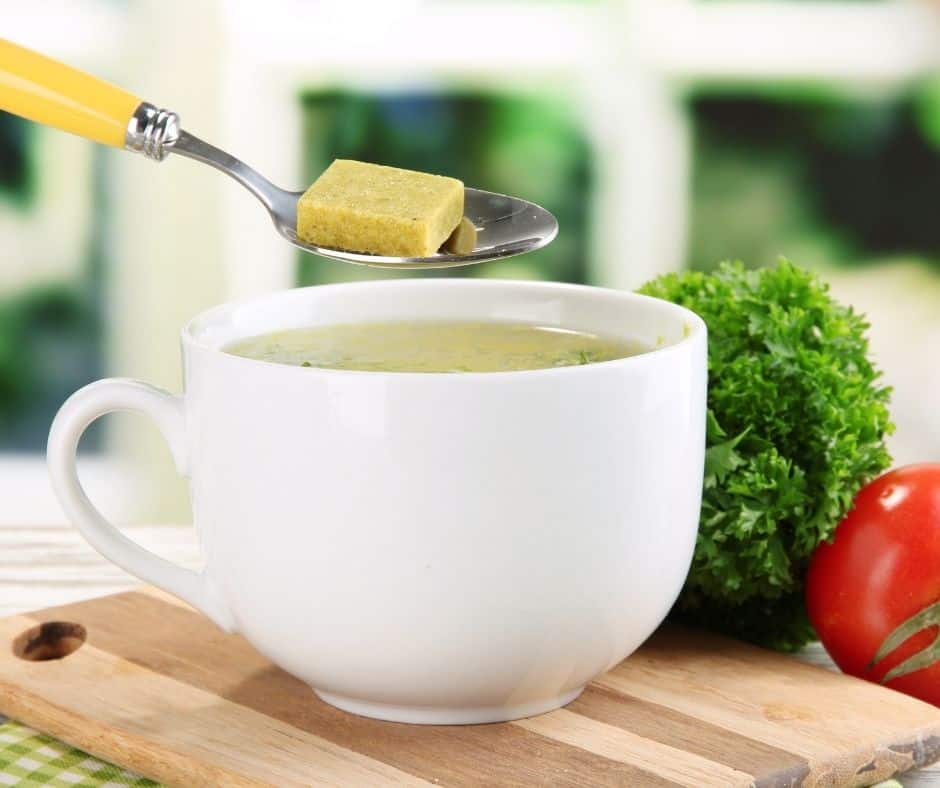Bouillon cubes, also known as stock cubes, are small blocks of dehydrated stock that dissolve quickly in hot water and provide flavor to soups, stews, sauces, and many other dishes. They are typically made from herbs, spices, dehydrated vegetables, poultry, meat stock, salt, and a few other food additives.

Because bullion cubes are very convenient, easy to use, and inexpensive, they are a staple of kitchen pantries everywhere. However, the bouillon cube is not an item of food that tends to generate much attention or excitement. For many, it’s seen as little more than a culinary hack and a shortcut. It’s a quick and easy way of creating a flavor that requires no brainpower.
Toss one into that watery pot of ingredients, and soon enough, you’ll have a tasty broth. Though it might not win any awards for glamour, this small, visually unspectacular block of dehydrated stock is actually more interesting and versatile than you’d think.
Historically, culturally, economically. For example, did you know that the bouillon cube dates all the way back to the 18th century? Or that it’s a central ingredient in a cult American cocktail? I’m guessing no and no (unless you’re a cocktail enthusiast).
There is far more to the bouillon cube than meets the eye. Here is every weird and wonderful thing you could ever wish to know about this cubed wonder:
15 Interesting Facts About Bouillon Cubes
1. The Name Comes From The French Verb Bouillir, Meaning ‘To Boil‘
“Bouillon” is a derivative of the French term bouillir, which means to boil. Outside of the US & Canada, the bouillon cube carries a different name, usually known as stock or broth cube. [1]
Although there may be contextual differences, bouillon, broth, and stock are very similar, and the terms are often used interchangeably. Celebrated American chef James Beard once stated this rather bluntly, insisting that they “are all the same thing.”
2. Pocket Soup Was A Precursor Of Meat Extract And Bouillon Cubes
A primitive version of bouillon cubes was invented in early 16th century Britain, going by the name of Portable Soup (also referred to as Pocket Soup or Veal Glue). It was made by boiling the feet and legs of cattle and drying the resulting gelatinous product, which would then be shaved into small tablets. [2] Pocket Soup was mainly used as a military ration for the army and navy.
3. It Took 30 kg Of Meat To Produce 1 kg Of Meat Extract
The invention of German chemist Baron Justus Von Liebig, Meat Extract was another popular flavourer that preceded bouillon cubes. Meat extract was a lump of high-concentrated meat (usually beef) flavoring designed for soups and broths. This creation’s main pitfall was just how uneconomical it was; it took a massive 30kg of meat to produce only 1kg of extract!
4. The Bouillon Cube As We Know It Today Was Invented By a French Chef
The bouillon cube is believed to be the invention of Auguste Escoffier, an acclaimed 19th-century French chef who was responsible for a number of other food preservation methods, including the canning of vegetables and tomatoes.
5. Industrially Produced Stock Cubes Were First Commercialized By Maggi in 1908
After discovering a method of extracting meaty flavors from wheat, Julius Maggi and his food manufacturing company were the first to mass-produce a commercial bouillonwürfel (bouillon cube) for the European market in 1908. British company OXO followed this in 1910, and German manufacturer Knorr in 1912. [3]
6. They Are Great For A Long Term Storage
Bouillon cubes can last up to 2 years when stored correctly. This is thanks to their generous salt content, which acts as a preserving agent, making them shelf-stable, and all they need is a dry and cool place like a cabinet in the kitchen or pantry.
7. About 100 Million Cubes Were Consumed During WW1
During the First World War, OXO gave the British armed forces 100 million stock cubes, each of which was individually hand-wrapped in foil. This served as an incredible marketing ploy for the company; stock cubes were an ideal trench food, and the Oxo brand became symbolic of the wartime effort.
8. Good Way To Replenish Electrolytes And Keeping Hunger at Bay
Given their low-calorie content, bouillon cubes are popular amongst dieters. One British man claimed that he lost 100kg by swapping out Cornish pasties in favor of OXO cubes. Makes sense! [4]Bouillon cubes can be particularly useful during low-carb diets such as the Keto, Paleo, and Atkins diets as they contain virtually no carbs and are high in sodium helping replace lost electrolytes.
9. One Of The Greatest Inventions In Gastronomy
Michelin-starred chef Marco Pierre White (and Knorr brand ambassador) once told a reporter that Knorr stock cubes are “one of the greatest inventions in gastronomy.” It would be fair to say there was a healthy dose of irony in this statement! [5]
10. Maggi Dominates West Africa’s Stock Cube Market (Valued at $375 Million)
Bouillon cubes are extremely popular in Central and West Africa, where 100 million are sold daily and are used to add flavor to everything from soups, rice, cassava porridge to stews. Maggi, in particular, have a large presence in this region; their cubes are ubiquitous in kitchens and on billboards, even being used in Senegal’s national dish Thieboudiene. [6]
11. The Bouillon Cube Market Is Increasing Exponentially
On a global scale, according to food industry statistics, the bouillon cube market is huge; Knorr alone sells approximately 600 million cubes per second. The 2020 pandemic saw an even greater worldwide demand for bouillon cubes.
According to Knorr, the period of February and March saw a 70% increase in sales. Projections suggest that the global bouillon cubes market will reach $5.9 Billion dollars by 2024.
12. Watch Out For Sodium!
Most bouillon cubes are very high in salt. Some of them are made of 50% salt, which is half a teaspoon of salt, and contain as much as 1500 mg of sodium per one cube. The average recommended amount of sodium is 2,300 mg per day for adults —that’s equal to about one teaspoon of salt! [7]
13. These Little Cubes Are Extremely Versatile
Bouillon cubes are not only meant for liquid foods; they can be used for seasoning steak, grilled chicken, roast potatoes, and even French fries. For some extra flavor, crumble one cube in cooking oil and warm it in the microwave for one minute. Then rub the oil mixture on your steak, chicken, or roast potatoes before cooking.
You can also make a marinade for your meat by blending apple cider vinegar, Worcestershire sauce, olive oil, minced garlic, spices, and crumble in one stock cube. Don’t add any extra salt!
Read Also: 4 Clever Ways to Cook Rice With Chicken Stock Cubes
14. Not So Vegan Friendly
Most meat-flavored bouillon cubes are not vegan. Beef, lamb, pork, chicken, ham, and fish stock cubes contain animal ingredients. Even most vegetable stock cubes are not vegan-friendly and may contain gelatin or E635 or be produced in the same environment as non-vegan products.
15. And Finally, There’s The Bullshot
A spin-off over the ever-popular Bloody Mary, the ‘Bullshot’ was a creation of Detroit’s historic Caucus Club during the early 1950s. This peculiar cocktail exchanges Mary’s tomato juice for beef bouillon. Certainly an acquired taste. [8]
